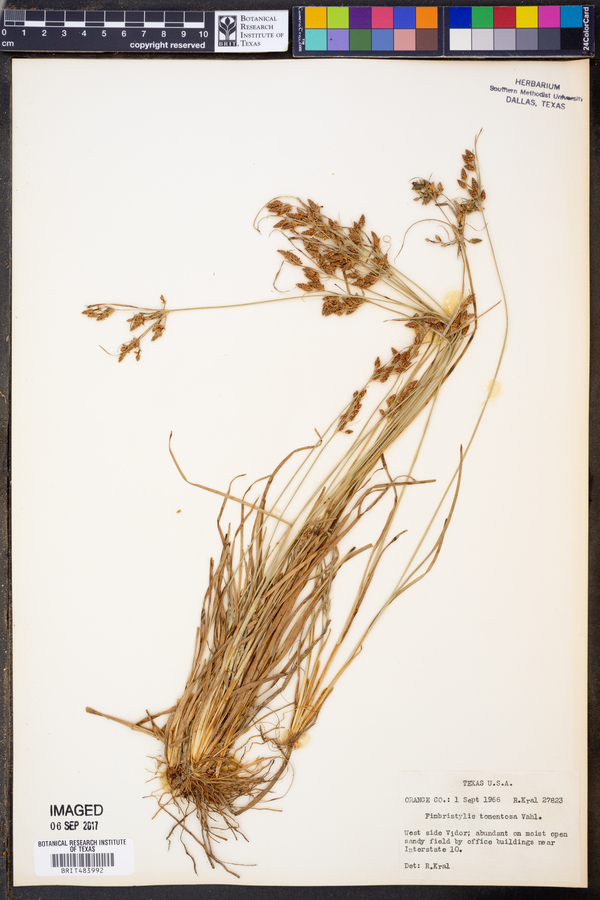Fimbristylis
|
Family: Cyperaceae |
Herbs, annual or perennial, usually cespitose, rhizomatous or not. Culms sometimes solitary, scapose, stiff or flaccid, terete, compressed, or 3-5-angled, coarse or fine. Leaves basal, distichous or polystichous; sheaths open apically, shorter than blade, with broad scarious margins; ligule absent at junction with blade or, if present, of erect short hairs, transverse, continuous or interrupted; blades flat or variously folded, terete, or sulcate, not prominently keeled on abaxial surface, the widest not more than 2 mm wide. Inflorescences simple or compound anthelae, rarely capitate; spikelets 1-80+, rarely single; involucral bracts 2-5, spreading or rarely erect, scalelike or leaflike. Spikelets mainly ovoid to lanceoloid or cylindric, sometimes compressed; scales 8-100+, spirally arranged, each subtending flower or proximal 1-2 empty. Flowers bisexual; perianth absent; stamens 1-3; styles flattened or subterete, 2-3-fid, base enlarged, deciduous. Achenes biconvex or trigonous, reticulate-honeycombed. Culms terminate in scapes; scapes are variously elongate, slender, shallowly to strongly ribbed, overtopping leaves. Leaf blades are mostly linear, compressed or thickened, rarely one facial. Involucral bracteal blades (more common than scales in Fimbristylis) are linear to setaceous, abbreviated or exceeding inflorescence. Spikelet scales are erect or ascending, rarely nearly distichous; proximal scales sterile, usually bladed, larger than fertile scales; fertile scales mostly uniform, carinate or convex, thin, medially with thicker, longitudinally ribbed band, margins entire; ribs converging apically, often short or long excurrent. Flowers are protandrous, on short rachilla joint; filaments flattened; anthers bilocular, two- to four-sporangiate; ovary two- to three-carpellate; styles disarticulating at very base, flat, fimbriate, or slender, angular, smooth or papillose. Achenes are tumid, obscurely three ribbed, with faces and angles variously sculpted.
Spikelets several to many in simple or compound, often umbelliform cymes or glomerules, forming a terminal infl subtended by a cluster of sheathless, leafy or scarious invol bracts; scales spirally imbricate; fls perfect; perianth none; stamens 1-3; style 2-3-cleft, wholly deciduous, usually enlarged at base, the unbranched part often flattened and fimbriate especially distally; radicle lateral; herbs with a few long, grass-like lvs near the base, the sheath entire or short-ciliate. 200, warm reg. Spp. 3-5 are closely related and might with some reason be treated as well marked vars. of the tropical F. spadicea (L.) Vahl. Gleason, Henry A. & Cronquist, Arthur J. 1991. Manual of vascular plants of northeastern United States and adjacent Canada. lxxv + 910 pp. ©The New York Botanical Garden. All rights reserved. Used by permission. |

